小学一二年级数学课到底应该上什么-推荐下载
- 格式:pdf
- 大小:292.91 KB
- 文档页数:5
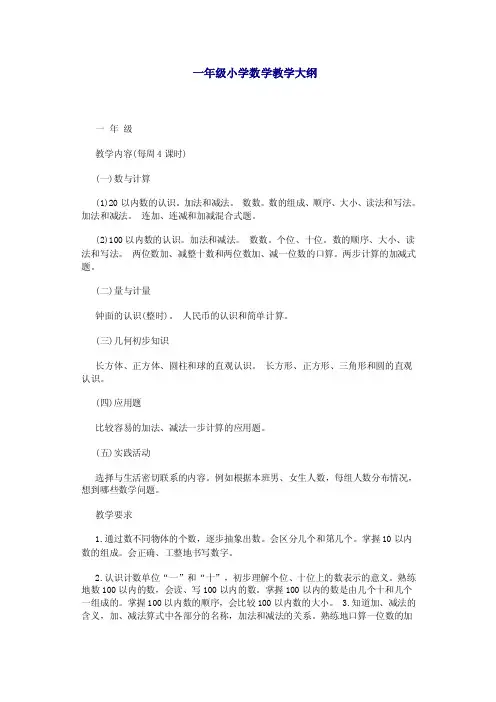
一年级小学数学教学大纲一年级教学内容(每周4课时)(一)数与计算(1)20以内数的认识。
加法和减法。
数数。
数的组成、顺序、大小、读法和写法。
加法和减法。
连加、连减和加减混合式题。
(2)100以内数的认识。
加法和减法。
数数。
个位、十位。
数的顺序、大小、读法和写法。
两位数加、减整十数和两位数加、减一位数的口算。
两步计算的加减式题。
(二)量与计量钟面的认识(整时)。
人民币的认识和简单计算。
(三)几何初步知识长方体、正方体、圆柱和球的直观认识。
长方形、正方形、三角形和圆的直观认识。
(四)应用题比较容易的加法、减法一步计算的应用题。
(五)实践活动选择与生活密切联系的内容。
例如根据本班男、女生人数,每组人数分布情况,想到哪些数学问题。
教学要求1.通过数不同物体的个数,逐步抽象出数。
会区分几个和第几个。
掌握10以内数的组成。
会正确、工整地书写数字。
2.认识计数单位“一”和“十”,初步理解个位、十位上的数表示的意义。
熟练地数100以内的数,会读、写100以内的数。
掌握100以内的数是由几个十和几个一组成的。
掌握100以内数的顺序,会比较100以内数的大小。
3.知道加、减法的含义,加、减法算式中各部分的名称,加法和减法的关系。
熟练地口算一位数的加法和相应的减法,比较熟练地口算两位数加、减整十数和两位数加、减一位数。
会计算加减法两步式题。
4.认识符号“=”、“>”、“<”,会使用这些符号表示数的大小。
5.认识钟面,会看整时。
认识人民币。
知道1元=10角,1角=10分。
要爱护人民币。
6.会根据加、减法的含义解答比较容易的加、减法一步计算的应用题。
知道题目中的条件和问题,会列出算式,注明得数的单位名称,口述答案。
7.培养学生认真做题、计算正确、书写整洁的良好习惯。
8.通过实践活动,使学生体验数学与日常生活的密切联系。
二年级小学数学教学大纲二年级教学内容(每周5课时)(一)数与计算(1)两位数加、减两位数。
两位数加、减两位数。
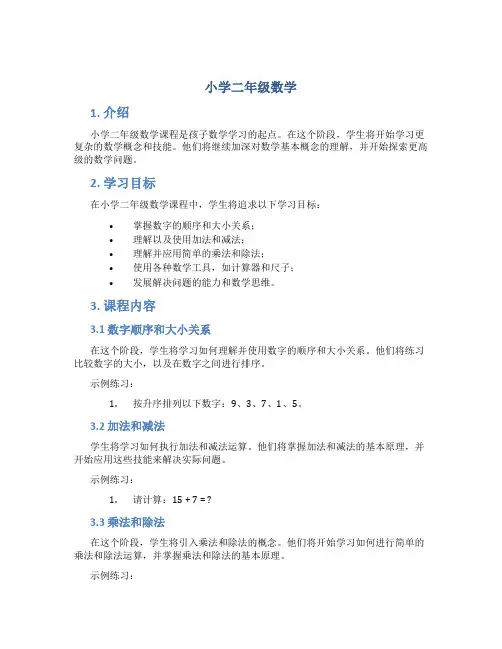
小学二年级数学1. 介绍小学二年级数学课程是孩子数学学习的起点。
在这个阶段,学生将开始学习更复杂的数学概念和技能。
他们将继续加深对数学基本概念的理解,并开始探索更高级的数学问题。
2. 学习目标在小学二年级数学课程中,学生将追求以下学习目标:•掌握数字的顺序和大小关系;•理解以及使用加法和减法;•理解并应用简单的乘法和除法;•使用各种数学工具,如计算器和尺子;•发展解决问题的能力和数学思维。
3. 课程内容3.1 数字顺序和大小关系在这个阶段,学生将学习如何理解并使用数字的顺序和大小关系。
他们将练习比较数字的大小,以及在数字之间进行排序。
示例练习:1.按升序排列以下数字:9、3、7、1、5。
3.2 加法和减法学生将学习如何执行加法和减法运算。
他们将掌握加法和减法的基本原理,并开始应用这些技能来解决实际问题。
示例练习:1.请计算:15 + 7 = ?3.3 乘法和除法在这个阶段,学生将引入乘法和除法的概念。
他们将开始学习如何进行简单的乘法和除法运算,并掌握乘法和除法的基本原理。
示例练习:1.请计算:6 × 3 = ?3.4 数学工具的使用学生将学习如何正确地使用各种数学工具,例如计算器和尺子。
他们将掌握这些工具的基本功能,并学会在解决问题时正确地使用它们。
示例练习:1.请使用计算器计算:47 + 29 = ?3.5 解决问题的能力和数学思维在小学二年级数学课程中,学生将培养解决问题的能力和数学思维。
他们将面临各种数学问题,并学会运用所学知识来解决这些问题。
示例练习:1.王明有15颗苹果,他送给了李华5颗苹果,还剩下多少颗苹果?4. 总结小学二年级数学课程的目标是培养学生的数学思维和解决问题的能力。
学生将学习数字的顺序和大小关系,掌握加法、减法、乘法和除法的基本原理,学会正确使用数学工具,并运用所学知识来解决各种数学问题。
通过这个课程,学生将奠定坚实的数学基础,以便在未来更深入地学习数学。
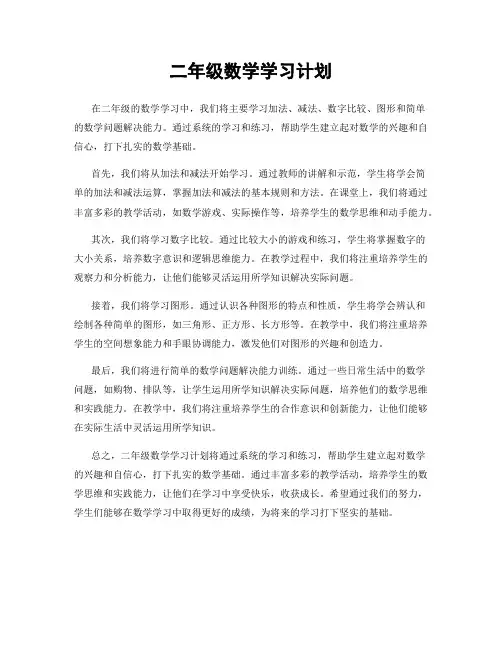
二年级数学学习计划
在二年级的数学学习中,我们将主要学习加法、减法、数字比较、图形和简单
的数学问题解决能力。
通过系统的学习和练习,帮助学生建立起对数学的兴趣和自信心,打下扎实的数学基础。
首先,我们将从加法和减法开始学习。
通过教师的讲解和示范,学生将学会简
单的加法和减法运算,掌握加法和减法的基本规则和方法。
在课堂上,我们将通过丰富多彩的教学活动,如数学游戏、实际操作等,培养学生的数学思维和动手能力。
其次,我们将学习数字比较。
通过比较大小的游戏和练习,学生将掌握数字的
大小关系,培养数字意识和逻辑思维能力。
在教学过程中,我们将注重培养学生的观察力和分析能力,让他们能够灵活运用所学知识解决实际问题。
接着,我们将学习图形。
通过认识各种图形的特点和性质,学生将学会辨认和
绘制各种简单的图形,如三角形、正方形、长方形等。
在教学中,我们将注重培养学生的空间想象能力和手眼协调能力,激发他们对图形的兴趣和创造力。
最后,我们将进行简单的数学问题解决能力训练。
通过一些日常生活中的数学
问题,如购物、排队等,让学生运用所学知识解决实际问题,培养他们的数学思维和实践能力。
在教学中,我们将注重培养学生的合作意识和创新能力,让他们能够在实际生活中灵活运用所学知识。
总之,二年级数学学习计划将通过系统的学习和练习,帮助学生建立起对数学
的兴趣和自信心,打下扎实的数学基础。
通过丰富多彩的教学活动,培养学生的数学思维和实践能力,让他们在学习中享受快乐,收获成长。
希望通过我们的努力,学生们能够在数学学习中取得更好的成绩,为将来的学习打下坚实的基础。
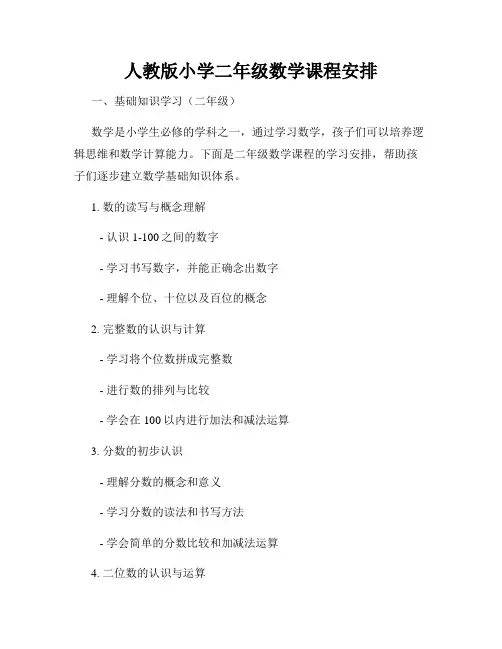
人教版小学二年级数学课程安排
一、基础知识学习(二年级)
数学是小学生必修的学科之一,通过学习数学,孩子们可以培养逻辑思维和数学计算能力。
下面是二年级数学课程的学习安排,帮助孩子们逐步建立数学基础知识体系。
1. 数的读写与概念理解
- 认识1-100之间的数字
- 学习书写数字,并能正确念出数字
- 理解个位、十位以及百位的概念
2. 完整数的认识与计算
- 学习将个位数拼成完整数
- 进行数的排列与比较
- 学会在100以内进行加法和减法运算
3. 分数的初步认识
- 理解分数的概念和意义
- 学习分数的读法和书写方法
- 学会简单的分数比较和加减法运算
4. 二位数的认识与运算
- 学习认识十位数和个位数
- 进行两位数的加减法运算
- 训练口算能力,提高计算速度
5. 数量与重量的认识
- 学习认识数目和重量的概念
- 进行简单的数量比较和重量比较
- 学习使用适当的计量单位进行计算6. 数据的处理与分析
- 学习观察和记录数据
- 统计数据,并画出简单的图表形式 - 分析数据,提取有用信息
7. 时间的认识与计算
- 理解时间的概念和意义
- 学会读写和绘制钟表
- 进行简单的时间计算,如加减法运算8. 金钱的认识与计算
- 认识不同面值的纸币和硬币
- 学会进行简单的金钱计算
- 解决与金钱相关的实际问题
以上是二年级数学课程的学习安排。
通过有步骤、有层次的学习,孩子们将逐渐掌握数学的基础知识和运算技巧,为日后更复杂的数学学习打下坚实的基础。
在学习过程中,家长可以提供良好的学习环境和积极的鼓励,帮助孩子们建立数学学习的兴趣和自信心。
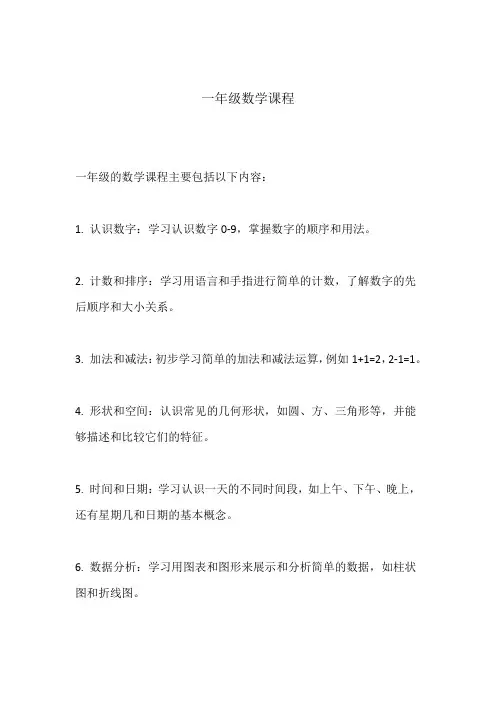
一年级数学课程
一年级的数学课程主要包括以下内容:
1. 认识数字:学习认识数字0-9,掌握数字的顺序和用法。
2. 计数和排序:学习用语言和手指进行简单的计数,了解数字的先后顺序和大小关系。
3. 加法和减法:初步学习简单的加法和减法运算,例如1+1=2,2-1=1。
4. 形状和空间:认识常见的几何形状,如圆、方、三角形等,并能够描述和比较它们的特征。
5. 时间和日期:学习认识一天的不同时间段,如上午、下午、晚上,还有星期几和日期的基本概念。
6. 数据分析:学习用图表和图形来展示和分析简单的数据,如柱状图和折线图。
这些内容旨在培养学生的数学思维和基本运算能力,为他们打下良好的数学基础。
教师会结合具体的教学资源和活动,使学生通过实践和探索来理解和运用数学知识。
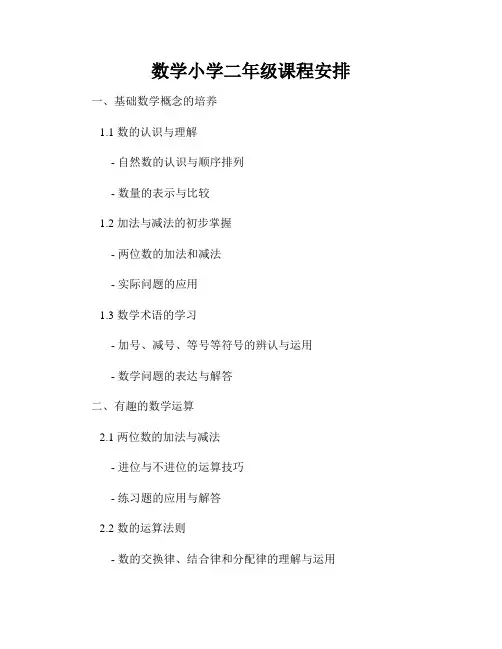
数学小学二年级课程安排一、基础数学概念的培养1.1 数的认识与理解- 自然数的认识与顺序排列- 数量的表示与比较1.2 加法与减法的初步掌握- 两位数的加法和减法- 实际问题的应用1.3 数学术语的学习- 加号、减号、等号等符号的辨认与运用- 数学问题的表达与解答二、有趣的数学运算2.1 两位数的加法与减法- 进位与不进位的运算技巧- 练习题的应用与解答2.2 数的运算法则- 数的交换律、结合律和分配律的理解与运用- 简单的实际问题解决三、数的应用与综合问题解决3.1 数的应用- 实际问题的数学表达与解决- 通过图形或实物的数量判断与比较3.2 综合问题解决- 阅读理解题、剪纸题等综合问题的解答 - 提高问题解决能力和逻辑思维能力四、补充练习与巩固4.1 练习题的完成- 教材习题的完成与巩固- 知识点的复习与运用4.2 数学游戏的参与- 数学游戏的开展与参与- 提升兴趣和培养数学思维能力五、总结与展望5.1 学习成绩的总结评价- 针对学生的学习表现,进行成绩评价与总结5.2 下一阶段课程的展望- 引入下一阶段的数学知识与应用- 继续培养学生的数学兴趣和能力通过以上课程安排,小学二年级学生将能够从基础的数学概念出发,逐步掌握加法和减法运算,并应用于实际问题中。
通过有趣的数学运算,培养学生对数学的兴趣和动手能力。
同时,通过数的应用与综合问题解决,提高学生的逻辑思维和问题解决能力。
最后,通过练习与巩固,对所学内容进行总结评价,并为下一阶段的数学学习做好展望和准备。
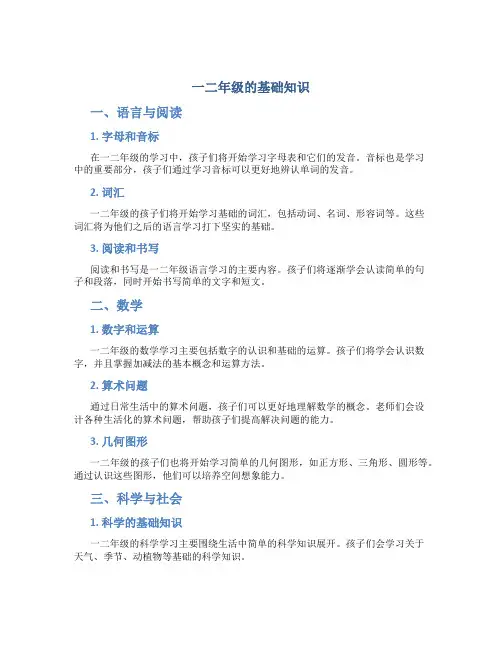
一二年级的基础知识一、语言与阅读1. 字母和音标在一二年级的学习中,孩子们将开始学习字母表和它们的发音。
音标也是学习中的重要部分,孩子们通过学习音标可以更好地辨认单词的发音。
2. 词汇一二年级的孩子们将开始学习基础的词汇,包括动词、名词、形容词等。
这些词汇将为他们之后的语言学习打下坚实的基础。
3. 阅读和书写阅读和书写是一二年级语言学习的主要内容。
孩子们将逐渐学会认读简单的句子和段落,同时开始书写简单的文字和短文。
二、数学1. 数字和运算一二年级的数学学习主要包括数字的认识和基础的运算。
孩子们将学会认识数字,并且掌握加减法的基本概念和运算方法。
2. 算术问题通过日常生活中的算术问题,孩子们可以更好地理解数学的概念。
老师们会设计各种生活化的算术问题,帮助孩子们提高解决问题的能力。
3. 几何图形一二年级的孩子们也将开始学习简单的几何图形,如正方形、三角形、圆形等。
通过认识这些图形,他们可以培养空间想象能力。
三、科学与社会1. 科学的基础知识一二年级的科学学习主要围绕生活中简单的科学知识展开。
孩子们会学习关于天气、季节、动植物等基础的科学知识。
2. 社会环境的认识除了科学知识,一二年级的孩子们还会认识到社会环境对他们的影响。
老师们会通过生活中的故事和实例,让孩子们了解社会规则和社会生活的一些基本常识。
四、艺术与体育1. 艺术表现一二年级的孩子们将通过绘画、手工和音乐等形式,表现自己的艺术天赋。
这也有助于培养他们的创造力和想象力。
2. 体育运动体育运动在一二年级学习中也扮演着重要的角色。
孩子们将通过体育活动,锻炼身体、培养团队合作精神和坚强意志。
以上就是一二年级学生的基础知识概述,通过这些基础知识的学习,孩子们将能够建立起扎实的知识基础,为未来的学习打下坚实的基础。

第一阶段(1~2年级)一年级上册:这一册教材包括下面一些内容:数一数,比一比,10以内数的认识和加减法,认识图形,分类,11~20各数的认识,认识钟表,20以内的进位加法,用数学,数学实践活动。
这一册的重点教学内容是10以内的加减法和20以内的进位加法。
这两部分内容和20以内的退位减法(一般总称一位数的加法和相应的减法)是学生学习认数和计算的开始,在日常生活中有广泛的应用,同时它们又是多位数计算的基础。
因此,一位数的加法和相应的减法是小学数学中最基础的内容,是学生终身学习与发展必备的基础知识和基本技能,必须让学生切实掌握。
除了认数和计算以外,教材安排了常见几何图形的直观认识,比较多少、长短和高矮,简单的分类,以及初步认识钟面等。
虽然每一单元的内容都不多,但是都很重要,有利于学生了解数学的实际应用,培养学生学习数学的兴趣。
这一册教材的教学目标是,使学生能够:1.熟练地数出数量在20以内的物体的个数,会区分几个和第几个,掌握数的顺序和大小,掌握10以内各数的组成,会读、写0~20各数。
2.初步知道加、减法的含义和加、减法算式中各部分名称,初步知道加法和减法的关系,比较熟练地计算一位数的加法和10以内的减法。
3.初步学会根据加、减法的含义和算法解决一些简单的实际问题。
4.认识符号“=”、“>”、“<”,会使用这些符号表示数的大小。
5.直观认识长方体、正方体、圆柱、球、长方形、正方形、三角形和圆。
6.初步了解分类的方法,会进行简单的分类。
7.初步认识钟表,会认识整时和半时。
8.体会学习数学的乐趣,提高学习数学的兴趣,建立学好数学的信心。
9.认真作业、书写整洁的良好习惯。
10.通过实践活动体验数学与日常生活的密切联系。
内容:一、数一数二、比一比三、1~5的认识和加减法四、认识物体和图形五、分类六、6~10的认识和加减法七、11~20各数的认识八、认识钟表九、20以内的进位加法一年级下册:这册教材包括下面一些内容:位置,20以内的退位减法,图形的拼组,100以内数的认识,认识人民币,100以内的加法和减法(一),认识时间,找规律,统计,数学实践活动。
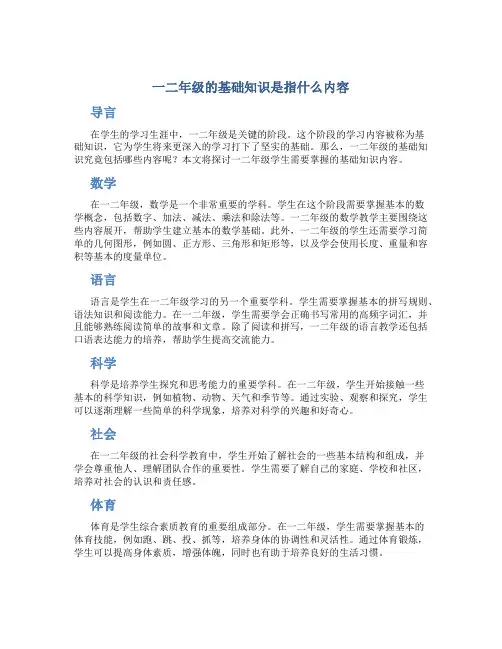
一二年级的基础知识是指什么内容导言在学生的学习生涯中,一二年级是关键的阶段。
这个阶段的学习内容被称为基础知识,它为学生将来更深入的学习打下了坚实的基础。
那么,一二年级的基础知识究竟包括哪些内容呢?本文将探讨一二年级学生需要掌握的基础知识内容。
数学在一二年级,数学是一个非常重要的学科。
学生在这个阶段需要掌握基本的数学概念,包括数字、加法、减法、乘法和除法等。
一二年级的数学教学主要围绕这些内容展开,帮助学生建立基本的数学基础。
此外,一二年级的学生还需要学习简单的几何图形,例如圆、正方形、三角形和矩形等,以及学会使用长度、重量和容积等基本的度量单位。
语言语言是学生在一二年级学习的另一个重要学科。
学生需要掌握基本的拼写规则、语法知识和阅读能力。
在一二年级,学生需要学会正确书写常用的高频字词汇,并且能够熟练阅读简单的故事和文章。
除了阅读和拼写,一二年级的语言教学还包括口语表达能力的培养,帮助学生提高交流能力。
科学科学是培养学生探究和思考能力的重要学科。
在一二年级,学生开始接触一些基本的科学知识,例如植物、动物、天气和季节等。
通过实验、观察和探究,学生可以逐渐理解一些简单的科学现象,培养对科学的兴趣和好奇心。
社会在一二年级的社会科学教育中,学生开始了解社会的一些基本结构和组成,并学会尊重他人、理解团队合作的重要性。
学生需要了解自己的家庭、学校和社区,培养对社会的认识和责任感。
体育体育是学生综合素质教育的重要组成部分。
在一二年级,学生需要掌握基本的体育技能,例如跑、跳、投、抓等,培养身体的协调性和灵活性。
通过体育锻炼,学生可以提高身体素质,增强体魄,同时也有助于培养良好的生活习惯。
总结一二年级的基础知识内容主要包括数学、语言、科学、社会和体育等多个学科。
通过学习这些基础知识,学生可以建立起良好的学习基础,为将来更深入的学习打下坚实的基础。
一二年级是学生发展的关键时期,学校和家庭需要共同努力,为学生提供一个良好的学习环境,帮助他们全面发展。
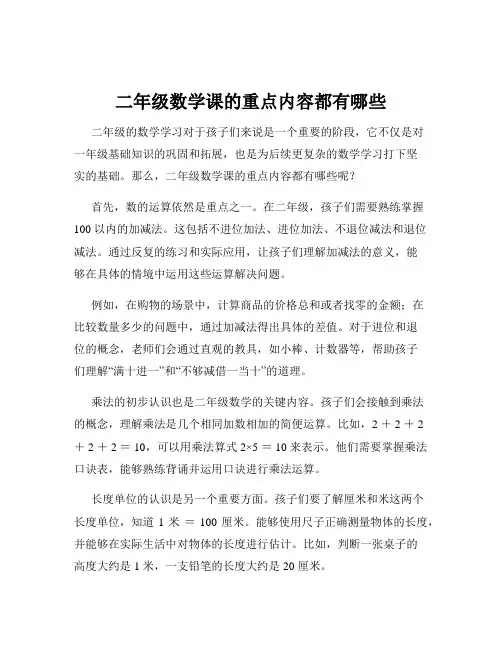
二年级数学课的重点内容都有哪些二年级的数学学习对于孩子们来说是一个重要的阶段,它不仅是对一年级基础知识的巩固和拓展,也是为后续更复杂的数学学习打下坚实的基础。
那么,二年级数学课的重点内容都有哪些呢?首先,数的运算依然是重点之一。
在二年级,孩子们需要熟练掌握100 以内的加减法。
这包括不进位加法、进位加法、不退位减法和退位减法。
通过反复的练习和实际应用,让孩子们理解加减法的意义,能够在具体的情境中运用这些运算解决问题。
例如,在购物的场景中,计算商品的价格总和或者找零的金额;在比较数量多少的问题中,通过加减法得出具体的差值。
对于进位和退位的概念,老师们会通过直观的教具,如小棒、计数器等,帮助孩子们理解“满十进一”和“不够减借一当十”的道理。
乘法的初步认识也是二年级数学的关键内容。
孩子们会接触到乘法的概念,理解乘法是几个相同加数相加的简便运算。
比如,2 + 2 + 2 + 2 + 2 = 10,可以用乘法算式 2×5 = 10 来表示。
他们需要掌握乘法口诀表,能够熟练背诵并运用口诀进行乘法运算。
长度单位的认识是另一个重要方面。
孩子们要了解厘米和米这两个长度单位,知道 1 米= 100 厘米。
能够使用尺子正确测量物体的长度,并能够在实际生活中对物体的长度进行估计。
比如,判断一张桌子的高度大约是 1 米,一支铅笔的长度大约是 20 厘米。
在图形的认识方面,二年级的孩子会学习角的初步认识。
了解角的组成部分,即一个顶点和两条边。
能够区分直角、锐角和钝角,通过实际的操作,比如用三角板去比一比,来判断一个角的类型。
此外,观察物体也是一个有趣的学习点。
孩子们需要从不同的角度观察物体,能够辨认从前面、后面、侧面等不同方向看到的物体形状。
这有助于培养他们的空间想象力和观察力。
数学广角部分,会涉及简单的排列组合和推理问题。
例如,用 1、2、3 三个数字可以组成哪些不同的两位数;通过已知条件进行简单的推理,找出正确的答案。
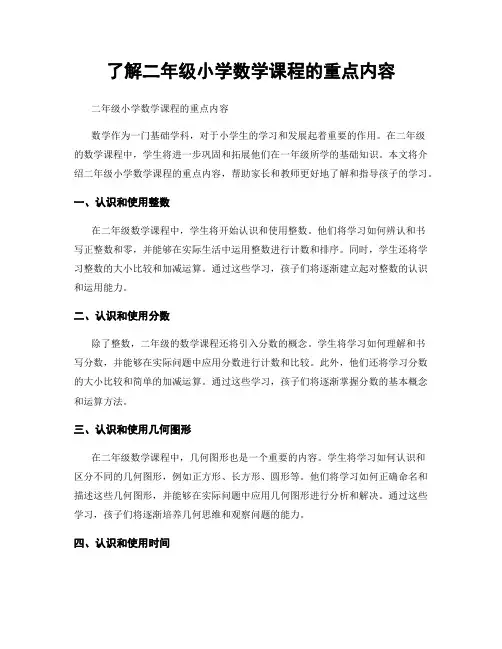
了解二年级小学数学课程的重点内容二年级小学数学课程的重点内容数学作为一门基础学科,对于小学生的学习和发展起着重要的作用。
在二年级的数学课程中,学生将进一步巩固和拓展他们在一年级所学的基础知识。
本文将介绍二年级小学数学课程的重点内容,帮助家长和教师更好地了解和指导孩子的学习。
一、认识和使用整数在二年级数学课程中,学生将开始认识和使用整数。
他们将学习如何辨认和书写正整数和零,并能够在实际生活中运用整数进行计数和排序。
同时,学生还将学习整数的大小比较和加减运算。
通过这些学习,孩子们将逐渐建立起对整数的认识和运用能力。
二、认识和使用分数除了整数,二年级的数学课程还将引入分数的概念。
学生将学习如何理解和书写分数,并能够在实际问题中应用分数进行计数和比较。
此外,他们还将学习分数的大小比较和简单的加减运算。
通过这些学习,孩子们将逐渐掌握分数的基本概念和运算方法。
三、认识和使用几何图形在二年级数学课程中,几何图形也是一个重要的内容。
学生将学习如何认识和区分不同的几何图形,例如正方形、长方形、圆形等。
他们将学习如何正确命名和描述这些几何图形,并能够在实际问题中应用几何图形进行分析和解决。
通过这些学习,孩子们将逐渐培养几何思维和观察问题的能力。
四、认识和使用时间在二年级的数学课程中,时间也是一个重要的内容。
学生将学习如何认识和使用钟表,掌握小时和分钟的概念,并能够读取和表示时间。
此外,他们还将学习如何计算时间的间隔和解决与时间相关的实际问题。
通过这些学习,孩子们将逐渐掌握时间的基本概念和运用能力。
五、认识和使用数据统计数据统计是二年级数学课程中的另一个重点内容。
学生将学习如何收集和整理数据,并能够使用图表和图形进行数据的展示和分析。
他们将学习如何读取和理解图表中的信息,并能够回答与数据相关的问题。
通过这些学习,孩子们将逐渐培养数据分析和解决问题的能力。
六、解决实际问题除了以上的重点内容,二年级的数学课程还注重培养学生的问题解决能力。
小学数学课程内容有哪些?哎呦喂,说起来小学数学,这可真是老本行!我当年教小学的时候,经常和孩子们打成一片,毕竟嘛,数学这东西,说白了就是个玩儿的游戏,关键是玩儿得开心,玩儿得明白。
咱们先说一说小学数学都学些什么吧,哈哈哈,这可真不少呢!首先,最基本的,数数,加减乘除,这些可是基础中的基础,就像盖房子得先打地基一样。
孩子们要学会数数,认识数字,会做一些简单的加减法,然后慢慢开始理解乘法的意义,最后学会用除法解决一些问题。
然后,咱们要认识一些基本的图形,比如三角形、正方形、圆形,还有长方形、平行四边形等等。
这些都是基础的几何知识,要让孩子们理解它们的特征,学会用尺子、三角板测量它们的边长和角度,最后还能算出它们的周长和面积。
除此之外,小学数学还有很多更有趣的内容,比如时间、长度、重量、容积等等。
这些都是孩子们日常生活经常接触到的东西,我们要让孩子们学会用数学语言来描述这些东西,比如用时间单位来表示时间的长短,用长度单位来表示长度的大小,用重量单位来表示物品的轻重,用容积单位来表示容器的容量。
当然,为了让孩子们更好地理解这些知识,我们要用一些生动活泼的方式来教学,比如讲故事、做游戏、玩数学游戏等等。
我记得有一次,为了让孩子们理解乘法的意义,我就用了一盒积木来做游戏。
我问孩子们:”如果我们要搭建一座高塔,需要10块积木,每层用4块积木,那我们要搭多少层呢?”孩子们就用积木一个一个地摆,数着每一个层数,最后就发现要搭2层半。
然后我就告诉他们,10块积木除以4块积木等于,这就是乘法的意义,就是用一个数乘以另一个数,就能得到一个新的数。
孩子们玩得津津有味,也慢慢地理解了乘法的意义,这就是数学教学的魅力所在。
总之,小学数学的课程内容丰富多彩,涵盖了数与计算、几何、统计、测量等多个方面,我们要让孩子们在学习的过程中感受到数学的乐趣,培养他们的数学思维能力和解决问题的能力。
最后,我再强调一下,学习数学最重要的不是死记硬背,而是要理解它的逻辑,把它运用到实际生活中,这才算真正掌握了数学知识。
小学二年级数学内容小学二年级数学内容主要包括加法、减法、乘法、除法、数的比较大小等基础知识。
在这个阶段,学生开始接触更加复杂的数学概念,需要通过实际操作和生动的教学方法来帮助他们建立数学思维和解决问题的能力。
首先,加法是小学二年级数学中的重要内容之一。
学生需要掌握从1到100以内的加法运算,包括进位和不进位的加法计算。
通过数学游戏和实际生活中的例子,可以帮助学生更好地理解加法的意义和运算方法。
其次,减法也是小学二年级数学中需要重点掌握的内容。
学生需要学会从1到100以内的减法运算,包括借位和不借位的减法计算。
老师可以通过故事、图画等形式,让学生在生动有趣的情境中学习减法,帮助他们理解减法的概念和运算规则。
除了加法和减法,乘法也是小学二年级数学中的重要内容。
学生需要掌握1到10的乘法口诀表,并能够进行简单的乘法计算。
通过数学游戏和实际物品的分组,可以帮助学生更好地理解乘法的概念和运算方法。
此外,除法也是小学二年级数学中需要学习的内容之一。
学生需要掌握1到100以内的除法运算,包括整除和余数的情况。
通过实际问题和教学案例,可以帮助学生理解除法的概念和运算规则。
最后,数的比较大小也是小学二年级数学中的基础内容。
学生需要学会通过比较符号(大于、小于、等于)来比较不同数的大小关系。
通过比较实际物品的大小、长度、重量等,可以帮助学生更好地掌握数的比较大小的方法。
总的来说,小学二年级数学内容涵盖了加法、减法、乘法、除法、数的比较大小等基础知识。
通过生动有趣的教学方式和实际操作,可以帮助学生更好地理解和掌握这些数学概念,为他们今后的数学学习打下坚实的基础。
小学数学二年级教学内容安排在2023年小学数学二年级教学中,我们将依然致力于让学生在轻松愉快的学习氛围中掌握数学基本概念和基本技能,培养他们的思维能力、创新能力和解决问题的能力。
一、数的认识和理解在小学数学二年级,数的认识和理解是一个重点。
我们将引导学生联系生活实际,从数的大小、数的变化,进而认识一些数码概念,比如个、十、百、千等等,并学习数的读法和写法。
同时,我们将让学生感受趣味性、实用性和可操作性,让他们通过游戏、实验等活动,调动学生学习数学的兴趣。
二、加减法的学习在小学数学二年级,加减法是数学教学的重要内容。
我们将以“把题目变成有趣的游戏”为主题,鼓励学生用“心算”、口算、实物模型等多种形式学习加减法。
学生将从这些方法中找到最适合自己的计算方法,提高他们的复杂计算能力。
三、计算方法和应用在小学数学二年级,我们将开始引导学生学习简单的算式,学习不同的计算方法和应用,如竖式、横式、口算、方格法等。
让学生通过练习和实践,理解各种方法的特点、优缺点,从而灵活掌握计算方法,巩固计算基础。
四、几何形状与位置在小学数学二年级,几何形状与位置也是一个重要的学习内容。
学生通过直观感知、讨论、活动等形式,探究平面图形间的相似、不相似的关系,进而学习分类和命名。
让学生领会形状和位置的特点和概念,建立直观的空间思维。
五、时间和单位换算在小学数学二年级,时间和单位换算也是一个需要重点关注的内容。
老师将会通过丰富的实例和游戏活动,引导学生认识日常生活和活动中的时间概念,会根据实际情况、寓教于乐地通过常见的方法,让学生理解并掌握秒、分、时、日、月、年等各种单位换算的方法。
总之,小学数学二年级的教学将以培养思维能力、巩固计算基础、发展创新精神为目的,继续坚持教学内容的兴趣性、实用性和操作性,使学生在轻松愉悦中学会许多有关数学的知识和技能,在未来的学习中得心应手。
一到六年级数学全部教材一年级数学教材数学是一门基础学科,对于孩子们的学习和成长至关重要。
在一年级数学教材中,主要着重培养学生的数感和逻辑思维能力。
以下是一年级数学教材内容的概览:1. 数字认知与计数:教授数字的基本概念,让学生认识到数字的含义和用途。
通过计算、分类和比较等活动,帮助学生培养出对数字的感觉和认知能力。
2. 加法和减法:从最简单的加法开始,逐渐引导学生掌握逐步增加难度的数学计算。
通过游戏和实际操作,巩固学生对加法和减法的理解和掌握程度。
3. 形状和空间:教授基本的几何形状,如圆、方形、三角形等,并帮助学生识别和描述不同形状之间的关系。
此外,还会引入简单的方向和位置概念,以培养学生的空间想象力。
4. 时间和日历:学习日常生活中的时间和日期概念,如小时、分钟、月份、星期等。
通过练习,帮助学生学会读取和解释日历,掌握简单的时间计算。
二年级数学教材在二年级数学教材中,学生将进一步巩固和拓展数学基础知识,为后续学习打下坚实的基础。
以下是二年级数学教材内容的概览:1. 基础运算:包括加法、减法、乘法和除法等基本运算的学习和巩固。
通过实际问题的解决,帮助学生理解运算的概念和应用。
2. 分数和小数:引入分数和小数的概念,并帮助学生理解分数和小数与整数之间的关系。
通过实际例子,让学生熟悉并掌握分数和小数的运算方法。
3. 分析统计:学习数据的收集、整理和汇总方法。
了解图表和图像的制作和解读,从而培养学生的数据分析和统计能力。
4. 量和度量:学习长度、重量、容量等量的基本单位和换算方法。
帮助学生掌握度量衡的概念和实际应用。
三年级数学教材三年级数学教材进一步扩展了学生的数学知识和技能,培养他们的逻辑思维和问题解决能力。
以下是三年级数学教材内容的概览:1. 大数和四则运算:学习更大的数字和更复杂的数学运算,如加减乘除的进一步应用和扩展。
通过解决实际问题,培养学生的计算能力和应用能力。
2. 平面图形:深入学习二维图形的属性和特征,如直线、曲线、多边形等。
二年级数学学习指南数学是一门重要的学科,也是培养学生逻辑思维和解决问题能力的基础。
在二年级,学生将进一步学习数的概念、加减法、乘法和除法等基本内容。
本文将为二年级学生提供一份数学学习指南,帮助他们掌握数学知识,提高数学能力。
一、认识数的概念在数学学习的起点,学生需要认识数的概念。
数是用来计数和度量的工具,它是抽象的概念,可以表示事物的数量。
在日常生活中,我们可以看到很多数字,比如门牌号码、年龄、体重等等。
通过观察和实践,学生可以逐渐理解数的概念。
为了帮助学生认识数的概念,老师可以设计一些有趣的活动。
比如,让学生数一数教室里有多少张桌子、多少个同学等等。
通过这些实际操作,学生能够直观地感受到数的概念和作用。
二、加法和减法加法和减法是数学学习的重要内容,也是日常生活中常用的计算方法。
在二年级,学生将学习两位数的加减法。
为了帮助学生掌握加减法,老师可以采用一些启发式的教学方法。
比如,通过使用计数器、小球等教具,让学生进行实际操作,体验加法和减法的过程。
同时,可以设计一些有趣的问题,让学生运用所学知识解决问题。
例如,小明有10个苹果,他吃了3个,还剩下几个?通过这样的问题,学生可以将数学知识与实际生活相结合,提高学习的兴趣和积极性。
三、乘法和除法乘法和除法是数学学习的进一步内容,它们是加法和减法的延伸和拓展。
在二年级,学生将学习乘法表和简单的除法运算。
为了帮助学生掌握乘法和除法,老师可以采用一些互动性强的教学方法。
例如,可以设计一些乘法表游戏,让学生通过游戏的方式记忆乘法表。
同时,可以设计一些实际问题,让学生运用乘法和除法解决问题。
比如,小明有3个篮子,每个篮子里有4个苹果,他一共有几个苹果?通过这样的问题,学生可以培养逻辑思维和解决问题的能力。
四、数学思维的培养数学学习不仅仅是掌握知识和技能,更重要的是培养学生的数学思维。
数学思维是一种逻辑思维和解决问题的能力,它能够帮助学生在面对复杂问题时,运用所学知识找到解决方法。
小学一二年级数学课到底应该上什么?在每一个人的记忆中,计算加减乘除都某种水准上代表着对数学的最初印象。
我们的数学课都是这样开始的。
数学课当然很重要!但外滩君觉得,这个热点事件背后,真正值得讨论的,其实是数学到底应该上什么,怎么上的问题。
如果数学课仍旧全等于加减乘除的练习,那这门课的确有需要反思的地方。
这样的讨论不但中国有,外滩君发现,国外的教育同行们同样在探讨数学到底该上些什么的话题。
计算机时代了,我们究竟应该拿加减乘除的数学课怎么办?这世上有很多东西在彻底分崩离析之前都不会显现出丝毫的改革迹象,就像如今的数学教育一样。
乍一看,似乎数学教育的学科基础坚不可摧。
数学学得怎么样直接决定了一个人未来的收入如何。
数学学科是如此的重要,以至于包括美国在内的很多国家,都向在数学领域有扎实基础的外国人才发放特别签证以求招贤纳士。
不过在这种表象背后却存有着严重的裂痕。
现实是,绝大部分学生不喜欢数学,不理解数学与现实生活的联系,即使考试题目变得越来越简单也依然成绩不佳。
大学和雇主们抱怨他们找不到拥有货真价实的数学技能的人才。
如今的数学教育在未来20年中将势必无法成为学校教育的主流。
它要么是屈服于某种恶性接管,要么就彻底无人问津。
事实上,学校里教的那些根本不能称之为“数学”。
学生学的仅仅计算罢了。
这是一项被淘汰的技能,因为现在几乎所有的计算都能够由计算机来完成。
除了在教育领域,计算还在通过人工来实行。
如果放在一个世纪以前,这可能还有点意义。
会计,物理,或是一些简单的工程模型就已经是人们希望使用数学能够解决问题的上限了。
但是今天,我们的水平显然不止于此。
技术的诞生和发展使得我们能够制造更加复杂的模型,我们的某些远见也变得切实可行,即使实际情况可能更复杂和模糊。
在过去的农业革命和工业革命中,技术已经提升了很多事务的可行性以及掌握某种技能的学习过程。
计算再也不是什么难题了。
所以,这显然已经不是绝大部分学生需要花费大量精力的地方了。
数学课当然很重要!但外滩君觉得,这一热点事件背后,真正值得讨论的,其实是数学到底应该上什么,怎么上的问题。
如果数学课仍旧全等于加减乘除的练习,那这门课的确有需要反思的地方。
这样的讨论不仅中国有,外滩君发现,国外的教育同行们同样在探讨数学到底该上些什么的话题。
计算机时代了,我们究竟应该拿加减乘除的数学课怎么办?这世上有很多东西在彻底分崩离析之前都不会显现出丝毫的改革迹象,就像如今的数学教育一样。
乍一看,似乎数学教育的学科基础坚不可摧。
数学学得怎么样直接决定了一个人未来的收入如何。
数学学科是如此的重要,以至于包括美国在内的许多国家,都向在数学领域有扎实基础的外国人才发放特别签证以求招贤纳士。
然而在这种表象背后却存在着严重的裂痕。
现实是,大多数学生不喜欢数学,不理解数学与现实生活的联系,即使考试题目变得越来越简单也依然成绩不佳。
大学和雇主们抱怨他们找不到拥有货真价实的数学技能的人才。
如今的数学教育在未来20年中将势必无法成为学校教育的主流。
它要么是屈服于某种恶性接管,要么就彻底无人问津。
事实上,学校里教的那些根本不能称之为“数学”。
学生学的只是计算罢了。
这是一项被淘汰的技能,因为现在几乎所有的计算都可以由计算机来完成。
除了在教育领域,计算还在通过人工来进行。
如果放在一个世纪以前,这可能还有点意义。
会计,物理,或是一些简单的工程模型就已经是人们希望使用数学能够解决问题的上限了。
但是今天,我们的能力显然不止于此。
技术的诞生和发展使得我们可以制造更加复杂的模型,我们的某些远见也变得切实可行,即使实际情况可能更复杂和模糊。
在过去的农业革命和工业革命中,技术已经提升了很多事务的可行性以及掌握某种技能的学习过程。
计算再也不是什么难题了。
因此,这显然已经不是大多数学生需要花费大量精力的地方了。
数学的核心是解决问题的过程。
你确定某一个现实生活中的问题,然后形成一种抽象的模型,计算出一个答案,然后再应用到最开始的那个现实问题中去。
在计算机发明以前,所有的人力都集中在第三步,也就是计算上。
而现在人们的精力花费在其他的步骤上。
但这一理念显然没有体现在数学教育上。
我们依旧坚持要求每个学生学习如何手动计算,至少在他们学会使用计算机以前。
然后我们还让他们计算一些简单却不现实的题目,而这些内容和生活中他们每天面对的问题一点关系都没有。
我们只是把学生变成了计算的机器。
然而现实世界需要的却是那些能够使用现代工具解决问题的人才。
事实证明,二次方程和长除法在如今的职场已经没什么用了。
人们需要的是如何让机器计算出我们所面临的问题的答案。
人们必须对学从数据中得到的结论保持怀疑的态度,训练用强有力的工具解决复杂的问题。
计算机被应用于各种学科的教学改革之中。
但对于数学来说,真正需要改变的是学科本身。
如果仅仅是用计算机帮助学生重复机械的手算是毫无意义的。
如果教育的内容本身错了,即使教的再好,或是使用多高明的技术,都无济于事。
我们需要利用计算机去解决实际生活中的数学问题,包括计算这一环节。
如今,英国已经重新将计算机编程引进了学校课程体系之中。
这不仅仅是一项职场技能,更是利用计算过程来代表数学概念。
编程应该成为新型计算机辅助数学的基础,甚至成为不可分割的一部分。
那些早早地采用了这种教学方法的人一定会获得巨大的回报,就像19世纪的时候那些首先应用全球性教育模式的先锋者一样。
在一些国家,诸如爱沙尼亚,政府已经高人一步地将眼光投向了提升Pisa考试(国际学生评估项目)成绩以外的领域,在他们眼中,职场和大学应该给数学教育提供更多的动力。
在1988年,史蒂芬·乔布斯就提出数学教育急需变革,呼吁教育工作者“关注数学实践,不要迷失在数学‘语法’中”。
要让这话成为现实,我们首先需要打败的是长久以来盘桓在数学教育领域毫不妥协、不求进取的态度,然后再去考虑技术应用的问题。
英语翻译:Math is very important! But the the Bund Jun think, this hot event behind, really worth discussing, in fact, what should be the problem of mathematics in the end. If the math class is equal to the total still add, subtract, multiply and divide the course of practice, it is need to reflect on the place. Such a discussion not only in China, the Bund Jun found that foreign education peers are also in the study of mathematics in the end what the topic.The computer age, how do the math we should take add, subtract, multiply and divide?A lot of things before collapsing completely are not showing the slightest signs of reform in the world, like today's mathematics education.At first glance, the discipline of Mathematics Education Foundation seems to be secure against assault. How to determine the future of a person directly determines how a person's future income. Mathematics is so important that many countries, including the United States, and to in the field of mathematics has a solid foundation of Foreign Personnel issued a special visa in order to careers.But there is a serious rift behind this phenomenon. The reality is that most students don't like math, and don't understand the connection between mathematics and real life, even though the exam questions are getting more and more simple and poor.University and employers complain that they can't find the genuine goods at a fair price with math skills talents. Today's mathematics education in the next 20 years will inevitably become the mainstream of the school education. It is either succumb to a malignant over, or completely No one shows any interest in.In fact, those who teach in the school can't be called "Mathematics" ". Students learn just to calculate. This is a skill that has been eliminated since it can be done by computer. In addition to the field of education, the calculation is still carried out by artificial.If you put it in a century ago, it might also be a bit of meaning. Accounting, physics, or some simple engineering model is the upper bound for the problem that people want to use mathematics to solve. But today, our ability is obviously more than that.The birth and development of technology has made it possible for us to make more complex models, and some of our vision has become feasible, even if the actual situation may be more complex and fuzzy.In the past the agricultural revolution and the industrial revolution, technology has promoted the feasibility of a lot of affairs and the learning process of mastering some skills. It's not a problem anymore. So this is clearly not the place where most students need to spend a lot of energy.The core of mathematics is the process of solving the problem. You identify a problem in a real life, and then form an abstract model to calculate an answer, and then apply it to the real problem in the beginning. Before the invention of the computer, all the human labor is concentrated in the third step, that is, the calculation. And now people's energy is spent on other steps.But this idea is clearly not reflected in the mathematics education. We still insist on each student to learn how to do it manually, at least before they learn to use the computer. And then we let them calculate some simple but unrealistic questions, and the contents of the daily life and the problems they face every day. We just turned the students into a computing machine. The real world needs, however, are those who can use modern tools to solve problems.Facts have proved that the two equations and long division in today's workplace has nothing to use. What is needed is how to get the machine to calculate the answers to the questions we are facing. People have to be skeptical about the resultsthey have learned from the data, and training with powerful tools to solve complex problems.The computer is applied to the teaching reform of various subjects. But for mathematics, the real need to change is the subject itself. It makes no sense if it is meaningless to use a computer to help the students repeat the machine. If the content of the education itself is wrong, even if it's good, or the use of more sophisticated technology, are useless. We need to use computers to solve problems in real life, including the calculation of the link.Today, the United Kingdom has been re introduced into the school curriculum system of computer programming. This is not just a workplace skills, it is the use of the calculation process to represent the concept of mathematics. Programming should become the basis of new computer aided mathematics, and even become an integral part of the.Those who have used this early in the morning will certainly have a huge return, like those in the first of the world's first use of the global sex education model in nineteenth Century.In some countries, such as Estonia, the government has an expert step will sights enhance PISA (International Student Assessment Project) results, in their eyes, the workplace and university should give more impetus to mathematics education.In 1988, Stephen Jobs put forward the reform of mathematics education in urgent need of education workers "pay close attention to the practice of mathematics, don't lose in the" grammar "of mathematics". Let these words become a reality, we first need to defeat is long linger in the field of mathematics education in uncompromising, not for enterprising attitude, and then go on to consider the application technology.。